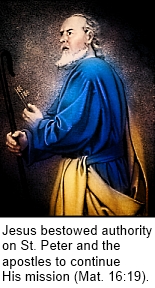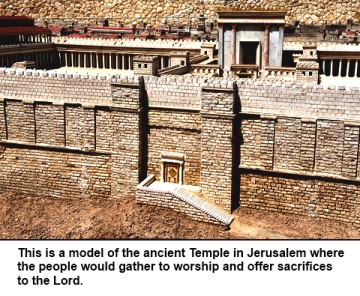Commentaries Index
"Freestyle
Christianity" continued...
The Post
Resurrection Disciples

In
the New Testament, outside of the gospels, the nature,
function and necessity of the Church become even more apparent.
St. Paul (I Corinthians 12:27, Ephesians 4:10-13) and St.
John (Revelation 19-22) refer to the Church as Christ’s
Body and His Body – being indicative of the covenantal
relationship between Jesus and a distinct people.
Another important aspect of
the analogy of the Body of Christ is that the Church
functions as the presence of Jesus in the world. In
other words, the Church
does not technically have its own mission, its primary
mission is the ministry of Jesus – a continuation of the
redemptive work He started on earth. Jesus equipped
the apostles and their successors with the authority and
power to lead, guide and provide the people with the
knowledge, support and graces (through Word and sacrament)
needed for salvation (Matthew 28:19-20, John 20:12-23).
The
Pattern
 If one takes a broad look at the Bible, a peculiar
reoccurring theme is prevalent throughout the Old and New
Testaments. It is a theme that is conducive to human
nature and necessary for our survival. We do not live
as completely autonomous beings, we are naturally
interdependent and social. From Abraham in the Old to
St. Paul in the New Testaments, no one comes to God
alone. A revelation can come to a person directly, but
it is then lived out or fulfilled in the context of human
interaction. “Going to God directly and worshiping him
by myself is all that is necessary” might sound fashionable
by today’s standards, but it is a concept that is completely
foreign to the experience of the People of God.
Abraham is the closest person to this concept because he was
the beginning of the Lord’s covenantal relationship with his
descendants, but even he had Melchizedek to bless him in the
name of the one true God (Genesis 14:17-24). Abraham
himself led his family in liturgical celebration by offering
holocausts and leading them in worship of the Lord.
From him, the practice of communal worship within an
organized liturgical celebration was codified and
perpetuated as a necessary expression of the covenantal
relationship of between God and His people (Exodus,
Deuteronomy, Numbers, etc.). In the New Testament,
communal worship is not only presented as continued
practice, but also as a characteristic that gave the
Christian people their identity (Acts 2).
If one takes a broad look at the Bible, a peculiar
reoccurring theme is prevalent throughout the Old and New
Testaments. It is a theme that is conducive to human
nature and necessary for our survival. We do not live
as completely autonomous beings, we are naturally
interdependent and social. From Abraham in the Old to
St. Paul in the New Testaments, no one comes to God
alone. A revelation can come to a person directly, but
it is then lived out or fulfilled in the context of human
interaction. “Going to God directly and worshiping him
by myself is all that is necessary” might sound fashionable
by today’s standards, but it is a concept that is completely
foreign to the experience of the People of God.
Abraham is the closest person to this concept because he was
the beginning of the Lord’s covenantal relationship with his
descendants, but even he had Melchizedek to bless him in the
name of the one true God (Genesis 14:17-24). Abraham
himself led his family in liturgical celebration by offering
holocausts and leading them in worship of the Lord.
From him, the practice of communal worship within an
organized liturgical celebration was codified and
perpetuated as a necessary expression of the covenantal
relationship of between God and His people (Exodus,
Deuteronomy, Numbers, etc.). In the New Testament,
communal worship is not only presented as continued
practice, but also as a characteristic that gave the
Christian people their identity (Acts 2).


 If one takes a broad look at the Bible, a peculiar
reoccurring theme is prevalent throughout the Old and New
Testaments. It is a theme that is conducive to human
nature and necessary for our survival. We do not live
as completely autonomous beings, we are naturally
interdependent and social. From Abraham in the Old to
St. Paul in the New Testaments, no one comes to God
alone. A revelation can come to a person directly, but
it is then lived out or fulfilled in the context of human
interaction. “Going to God directly and worshiping him
by myself is all that is necessary” might sound fashionable
by today’s standards, but it is a concept that is completely
foreign to the experience of the People of God.
Abraham is the closest person to this concept because he was
the beginning of the Lord’s covenantal relationship with his
descendants, but even he had Melchizedek to bless him in the
name of the one true God (Genesis 14:17-24). Abraham
himself led his family in liturgical celebration by offering
holocausts and leading them in worship of the Lord.
From him, the practice of communal worship within an
organized liturgical celebration was codified and
perpetuated as a necessary expression of the covenantal
relationship of between God and His people (Exodus,
Deuteronomy, Numbers, etc.). In the New Testament,
communal worship is not only presented as continued
practice, but also as a characteristic that gave the
Christian people their identity (Acts 2).
If one takes a broad look at the Bible, a peculiar
reoccurring theme is prevalent throughout the Old and New
Testaments. It is a theme that is conducive to human
nature and necessary for our survival. We do not live
as completely autonomous beings, we are naturally
interdependent and social. From Abraham in the Old to
St. Paul in the New Testaments, no one comes to God
alone. A revelation can come to a person directly, but
it is then lived out or fulfilled in the context of human
interaction. “Going to God directly and worshiping him
by myself is all that is necessary” might sound fashionable
by today’s standards, but it is a concept that is completely
foreign to the experience of the People of God.
Abraham is the closest person to this concept because he was
the beginning of the Lord’s covenantal relationship with his
descendants, but even he had Melchizedek to bless him in the
name of the one true God (Genesis 14:17-24). Abraham
himself led his family in liturgical celebration by offering
holocausts and leading them in worship of the Lord.
From him, the practice of communal worship within an
organized liturgical celebration was codified and
perpetuated as a necessary expression of the covenantal
relationship of between God and His people (Exodus,
Deuteronomy, Numbers, etc.). In the New Testament,
communal worship is not only presented as continued
practice, but also as a characteristic that gave the
Christian people their identity (Acts 2).